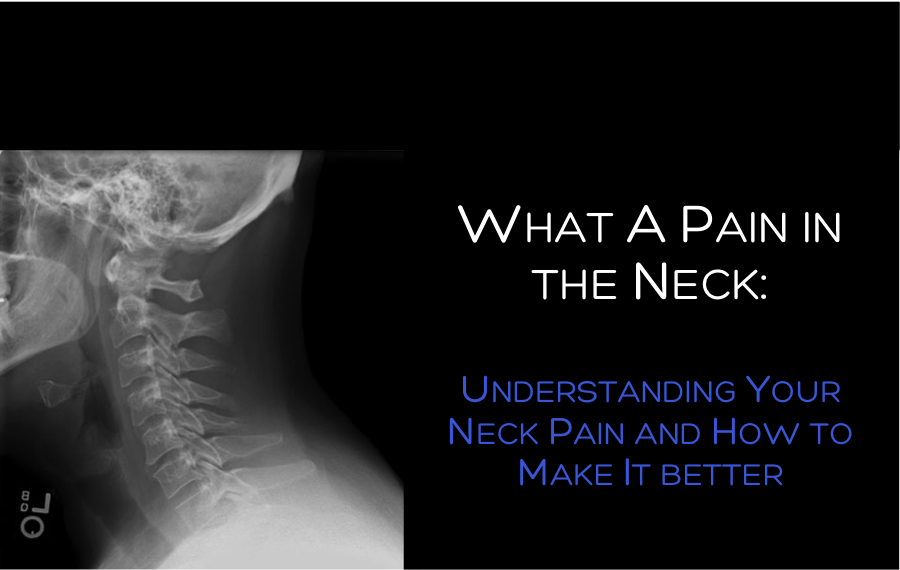[blog_subscription_form]
My approach to treating neck pain
As someone who has suffered from neck pain for most of my life, I understand how debilitating it is without treatment. It stops us from doing what we love, and making what we love to do less enjoyable.
I believe that with the proper treatment, exercise prescription and deciphering what major stresses that your neck experiences, we can help to reduce your neck pain. In some cases we can also stop it from coming back. A detailed and thorough assessment will determine what postural and ergonomic connections should be made, which muscles are tight, which muscles are weak, and what treatment options and exercises will best suit you.
Neck pain can arise from poor posture, the way you breath or hold your head, an immobility of the thoracic spine, a bad pillow or bed, weakness in certain muscle groups, previous trauma, or stress. We will help to determine what your crux is and help to eliminate it.
The best way to treat neck pain is to understand that everything in the body is connected and the neck does not operate in isolation. To treat the neck effectively, one should help to improve movement in the upper back, upper limb, and shoulder girdle, as the dozens of neck muscle originate from these locations. Using a combination of massage, adjusting, acupuncture, postural correction and exercise, we will help to restore strength in the neck, improve movement in the joints, relax tight muscles, and stop your neck pain.
Why is this Neck Pain happening to me?
Neck pain is an incredibly common complaint that is suffered by the vast majority of the North American population. It is estimated that between 30%-50% of adults will experience neck pain in a given year1. The common experience of most adults (50%-85%) is that neck pain is a persistent ongoing condition with episodes occurring over a lifetime with variable periods of recovery in between. Neck pain is experienced as episodic bouts, best thought of as peaks and troughs in the degree of symptoms experienced.
Episodes of exacerbated neck pain generally last between days and weeks. Seeking treatment can help to reduce the length and intensity of these exacerbation, and likely reduce the frequency of future occurrences.
Types of Neck Pain
Over 90% of neck pain is considered mechanical. This means that the source of pain comes from the muscles, ligaments and joints. This represents the overwhelming source of most people’s neck pain and is a good diagnosis because chiropractors and other manual practitioners are wonderful at treating this type of pain.
Only very, very rarely is neck pain attributable to an injury to an intervertebral disc, disc herniation, pinched nerve or radiculopathy. While neck pain of this type generally takes longer to get better, chiropractors and other manual practitioners are also prepared to treat this type of pain.
In only the most serious of cases, and very rarely, is neck pain attributable to a dangerous and more serious condition that is non-mechanical. In these cases, treatment would require collaborative care between your medical doctor and a chiropractor (cancer, inflammatory arthritis, bone disease, infection, other nasty things).2
Why does my neck hurt?
Pain is felt when certain nerves in the neck are stimulated and communicate a signal to the brain that is interrupted as pain. In most cases of neck pain, the cause is a repetitive strain injury to the muscles, ligaments, or joints of the neck from prolonged poor posture such as sitting with poor posture for extended periods of time at the office, sleeping with the neck in an awkward position, or straining the neck while at the gym, or playing sports.
In most of these cases, there is no major damage or injury to the neck that is permanent or long-lasting. Most neck pain results from muscle tightness or strain, joint stiffness, irritation, immobility or stress causing the activation of pain detecting nerve fibers.
Neck Stress
It is important to understand that stress or anxiety can be both a major cause and perpetuating factor of neck pain, One’s psychological state, in terms of stress, anxiety and more, is an undeniably important factors known to increase the perception of pain, and could create tension in the neuromuscular system of the neck to cause and perpetuate neck pain. Given that the nerves are responsible for telling the brain that there is something irritated within the neck muscles and joints, anything that makes the nervous system more active and sensitive, will make one more sensitive to feeling pain
What are the major causes of neck pain? Why does my neck pain come back?
Even after excellent treatment, the statistics show that most people will experience recurrent neck pain. Based on the scientific literature, it is my belief that unless the stress and strain that our necks experience between visits to your health care practitioner are reduced, it is likely that your neck pain will come back. Proper exercise rehabilitation will also provide a great deal of relief, and reduce the frequency of future occurrences
The following are some of the many stresses that our neck experience that can compound, and result in the recurrence of neck pain.
- habitual prolonged sitting or computer use3
- sustained dysfunctional neck posture such as waking up with a “kink in the neck”
- improper pillow size or poor pillow use
- repetitive strain to the neck during exercise, sports or activity
- minor trauma sustained during a motor vehicle accident or sports injury
- high stress or habitual chest breathing4 – read for about this here
Why is there pain travelling into my arm or back
Pain can travel into the back or arm as a result of referred pain ,or radiating nerve pain.
Referred pain is characterized by a dull or sharp ache felt in the upper limb, shoulder or back, coinciding with pain in the neck. Referred pain is analogous to pain felt in the left arm, shoulder or jaw when experiencing a heart attach. It is pain felt in an area of the body where there is no injury (ie shoulder) but is perceived because of redundancy in the nervous system. This redundancy means that the neck and the shoulder in this case, share similar nerve connections and the brain has difficulty determining where the pain is coming from. It is often the result of a trigger point in a muscle, or irritation of a ligament, or joint tissue.
Radicular (= nerve) pain is characterized by sharp, shooting, electrical or burning pain travelling from the neck into the shoulder, arm, and often forearm. It is like a lightening bolt travelling down the arm. This occurs as the result of either direct nerve compression, chemical stimulation of a nerve, or tension on a nerve. Nerves leave the spinal cord, travelling out through the vertebral column of the neck and move through the muscles of the neck, shoulder and arm while forming an intricate network of connections and offshoots along the way. This type of neck pain is rare (<10% of cases) and can be the result of a disc herniation or disc injury, very tight musculature in the neck or a number of other reasons. While it is generally benign, it is wise to consult a health care practitioner to determine its origin is not serious.
Both of the types of pain are very common with mechanical neck pain and generally dissipate with treatment.
Does arthritis (degeneration) in the neck always cause neck pain?
The best evidence to date says that symptoms cannot be predicted based on degenerative (arthritis ) changes on an x-ray. Arthritis does not always cause pain, and pain is not always attributable to arthritis. Because of this phenomenon, it is possible for some people to have very bad arthritis in the cervical spine and be completely asymptomatic. The vast majority of patients I see are young office workers with no arthritis but often debilitating neck pain.
Do I need an x-ray, ultrasound, or MRI of my neck
X-rays are very useful for detecting changes in the bones of the skeleton and their relative alignment. Ultrasound and MRI (magnetic resonance imaging) are very good at looking at the intimate structural details of the body and can detect subtle changes in the tissues of the body.
The best research that chiropractors and doctors have to make decisions on says that in the vast majority of cases, an x-ray or other imaging is not needed to properly diagnose neck pain. As noted, most (over 90%) of neck pain is from the muscles, joints and nerves, which x-ray is not able to detect changes in. The best research tells us that neck pain is best diagnosed from patient history, what the doctor feels through palpation, and other orthopedic testing.
Unless your doctors feels that an x-ray is needed because of certain symptoms, the mechanism of injury or based on the Canadian Cervical Spine Rules for X-ray, is a radiograph usually recommended. 2
What treatments are proven and recommended for the treatment of neck pain
The Neck Pain Task Force study is the most comprehensive and thorough investigation to date on the topic of neck pain. This study evaluated 1000’s of scientific experiments to produce guidelines for the assessment, diagnosis and treatment of neck pain. The following are their findings for the most and least effective care modalities to help you with your neck pain
These treatments are effecting for non-traumatic neck pain
- manipulation
- mobilization
- supervised exercise
- manual care with exercise
- acupuncture
- LLLT (Low Level Laser Therapy)
- Analgesics
Effective treatments for acute traumatic neck pain:
- Educational video
- Mobilization
- Exercises
- Mobilization plus exercise
References
- Carroll, Linda J., et al. “Course and prognostic factors for neck pain in the general population: results of the Bone and Joint Decade 2000–2010 Task Force on Neck Pain and Its Associated Disorders.” Journal of manipulative and physiological therapeutics2 (2009): S87-S96.
- Haldeman, Scott, et al. “The bone and joint decade 2000–2010 task force on neck pain and its associated disorders: executive summary.” Journal of manipulative and physiological therapeutics2 (2009): S7-S9.
- Lau, Kwok Tung, et al. “Relationships between sagittal postures of thoracic and cervical spine, presence of neck pain, neck pain severity and disability.” Manual therapy5 (2010): 457-462.
- Wirth, B., et al. “Respiratory dysfunction in patients with chronic neck pain–Influence of thoracic spine and chest mobility.” Manual therapy5 (2014): 440-444.




